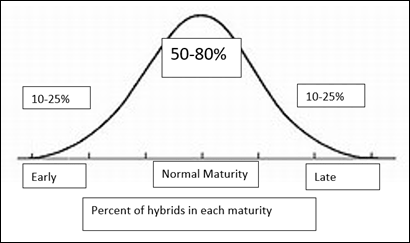Agronomy Update: Using 2019 Data to Plan Ahead for 2020
BY DAIRYLAND SEED AGRONOMY TEAM
MAKING SENSE OF PLOT DATA: 2019
Even as many continue to struggle with harvest through snow, rain, mud, weak stalks, wet soybeans, there is a lot of yield data becoming available. It is a challenge every year to make sense of the data and to use it appropriately to make seed purchase decisions for 2020. Here are a few thoughts:
- First, a cautionary note on plots and data from this year. Much of the crop was planted late – in June, not in May – and, therefore, much of the plot data is from late plantings. June planting doesn’t mean invalid data, but hybrids often do respond quite differently depending on timing of planting. Make sure you know planting dates and take that into consideration in evaluating yield and quality data.
- Multi-year data is always more valuable than single year data. We all know that, yet it is easy to just look at this year’s data and “plant the hot hybrid next year”. We all know that hybrid performance from one year to the next varies. The more multi-year data you can look at, the better the chance of making good hybrid and variety selections for next year.
- Yield data closest to home is more valuable. Data from another state may offer some help, but soils and weather conditions are often so different from your own situation that you need to look at “far away” data with a “big grain of salt”.
- Company data can be quite useful, but make sure the company reported the whole plot including competitive product performance.
- Third party plots (university trial, FIRST plots, etc.) are often good sources of information.
Dairyland Seed has released a large number of new hybrids over the past two years, and that trend will continue as our breeding program is expansive, deep, and quick. Our soybean lineup is changing rapidly as we transition to the Enlist™ soybean platform. We do have a lot of excellent performance data to share, and we look forward to discussing hybrid and variety performance with you.
MATURITY PLANTING BELL CURVE
As harvest continues many producers have been, or soon will be, looking at what hybrids they will be planting next year. Yield is always paramount in those decisions; however, agronomic placement is a close second. One factor that is not always apparent in some on of these decisions is maturity considerations or as some have put it the Maturity Planting Bell Curve.
Maturity Planting Bell Curve is where you plant 10 to 25 percent of your crop to an early maturing hybrid or variety, 50 to 80 percent to your standard maturity range, and 10 to 25 percent to a later maturity.
|
10-25% |
Early Relative Maturity |
|
50-80% |
Normal Relative Maturity |
|
10-25% |
Later Relative Maturity |
The reasoning behind planting multiple hybrids of varying relative maturities is to spread out your risk should you hit a hot and dry period during that ever-critical pollination period. By spreading out your relative maturity you, in theory, also spread out your harvest and drying facility load or bottleneck.
Over the years agronomists and seed sellers have typically recommended that producers plant hybrids that reach maturity 7 to 12 days before the average first freeze date. This allows time for products to reach R6 or Physiological Maturity / Black Layer naturally. (This, in turn, generally produces the best yield, test weight and also allows for better dry down.) The rule of thumb I use is that for every one day increase in relative maturity you need to increase the Growing Degree Day or Unit (GDU) by 20-25 GDU to reach maturity. Conversely, in my experience, grain moisture will increase at harvest 0.2 - 0.5 percent for every one day increase in relative maturity.
A common recommendation of mine to growers is to plant an early day or their normal relative maturing hybrid in their first field, followed by their late maturing hybrids and then the rest of their hybrids. In this way, all of their hybrids would not be pollinating at the same time. If you plant all of your later day relative maturity first, followed by your normal relative maturity and then your early day maturity, odds are they will all pollinate at the same time, which increases your risk of inclement weather at pollination. The other aspect of this is that by planting an early relative maturity first on a field or two you are also allowing for greater harvest flexibility and or capturing a grain marketing opportunity.

If you have question regarding what hybrids or maturity range is best for your operation, please contact your local Dairyland Seed Dealer, District Sales Manager or Agronomist to help with these needs.
EARLY PAY DISCOUNT
Don’t miss out on our Early Pay Discount! The next deadline is November 15, 2019. Contact your local sales rep or the Dairyland Seed Financial Services Department for more information.
 |
 |
 |
 |
 |
| Brian Weller Western Region 507.456.3034 |
Dan Ritter Central Region 219.863.0583 |
Branden Furseth Northern Region 608.513.4265 |
Rod King Eastern Region 574.596.6721 |
Terry Jones Eastern Region 419.630.3115 |
